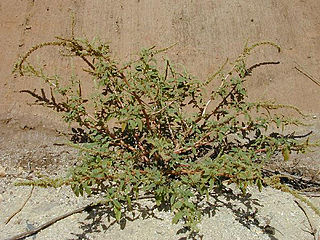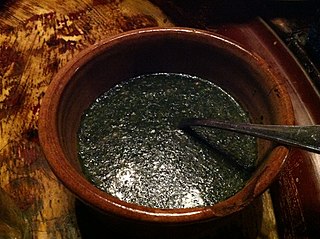
Amaranthus is a cosmopolitan genus of annual or short-lived perennial plants collectively known as amaranths. Some amaranth species are cultivated as leaf vegetables, pseudocereals, and ornamental plants. Catkin-like cymes of densely packed flowers grow in summer or autumn. Amaranth varies in flower, leaf, and stem color with a range of striking pigments from the spectrum of maroon to crimson and can grow longitudinally from 1 to 2.5 metres tall with a cylindrical, succulent, fibrous stem that is hollow with grooves and bracteoles when mature. There are approximately 75 species in the genus, 10 of which are dioecious and native to North America with the remaining 65 monoecious species endemic to every continent from tropical lowlands to the Himalayas. Members of this genus share many characteristics and uses with members of the closely related genus Celosia. Amaranth grain is collected from the genus. The leaves of some species are also eaten.

Amaranthus viridis is a cosmopolitan species in the botanical family Amaranthaceae and is commonly known as slender amaranth or green amaranth.

Amaranthus hypochondriacus is an ornamental plant commonly known as Prince-of-Wales feather or prince's-feather. Originally endemic to Mexico, it is called quelite, bledo and quintonil in Spanish.

Amaranthus spinosus, commonly known as the spiny amaranth, spiny pigweed, prickly amaranth or thorny amaranth, is a plant that is native to the tropical Americas, but is present on most continents as an introduced species and sometimes a noxious weed. It can be a serious weed of rice cultivation in Asia.

Amaranthus tricolor, known as edible amaranth, is a species of flowering plant in the genus Amaranthus, part of the family Amaranthaceae.
Amaranthus thunbergii, commonly known as Thunberg's amaranthus or Thunberg's pigweed, is found in Africa.

Amaranthus dubius, the red spinach, Chinese spinach,, spleen amaranth, hon-toi-moi, yin choy, hsien tsai, or Arai keerai is a plant species. It belongs to the economically important family Amaranthaceae.

Amaranthus cruentus is a flowering plant species that yields the nutritious staple amaranth grain. It is one of three Amaranthus species cultivated as a grain source, the other two being Amaranthus hypochondriacus and Amaranthus caudatus. In Mexico, it is called huautli (Spanish pronunciation: [ˈwawtli] and alegría ([aleˈɣɾi.a] and in English it has several common names, including blood amaranth, red amaranth, purple amaranth, prince's feather, and Mexican grain amaranth.

Cnidoscolus aconitifolius, commonly known as chaya, tree spinach, or spinach tree, is a large, fast-growing and leafy perennial shrub that is believed to have originated in the Yucatán Peninsula of Mexico. The specific epithet, aconitifolius, means "Aconitum-like leaves". It has succulent stems that exude a milky sap when cut.

Mulukhiyah, also known as molokhia, molohiya, or ewedu, is a dish made from the leaves of Corchorus olitorius, commonly known in English as denje'c'jute,nalta jute, tossa jute, jute mallow or Jew's Mallow. It is used as a vegetable and is mainly eaten in the Levant, Egypt, Sudan, Cyprus, Libya, Tunisia and Algeria. It is called “Saluyot” in the Philippines. Mulukhiyah is rather bitter, and when boiled, the resulting liquid is a thick, highly mucilaginous broth; it is often described as "slimy", rather like cooked okra. Mulukhiyah is generally eaten cooked, not raw, and it is either eaten chopped and sautéed in oil, garlic and cilantro like in Syria or turned into a kind of soup or stew like in Egypt, typically bearing the same name as the vegetable in the local language. Traditionally mulukhiyah is cooked with chicken or at least chicken stock for flavor and is served with white rice, accompanied with lemon or lime.

Species belonging to the genus Amaranthus have been cultivated for their grains for 8,000 years. Amaranth plants are classified as pseudocereals that are grown for their edible starchy seeds, but they are not in the same botanical family as true cereals, such as wheat and rice. Amaranth species that are still used as a grain are Amaranthus caudatus L., Amaranthus cruentus L., and Amaranthus hypochondriacus L. The yield of grain amaranth is comparable to that of rice or maize.

Corchorus capsularis, commonly known as white jute, is a shrub species in the family Malvaceae. It is one of the sources of jute fibre, considered to be of finer quality than fibre from Corchorus olitorius, the main source of jute. The leaves are used as a foodstuff and the leaves, unripe fruit and the roots are used in traditional medicine.
Acalypha bipartita is a species in the botanical family Euphorbiaceae. It occurs widely in Africa where it is eaten as a vegetable, or fed to animals. The leaves are considered nutritious, as they contain a high concentration of calcium. It is often found as undergrowth in the forest, on the edges of the forest, and in wooded grasslands, particularly in Sudan, Uganda, Kenya, eastern Zaire, Burundi, Rwanda, and Tanzania. The stems are often used in making baskets.

Alternanthera sessilis is a flowering plant known by several common names, including sissoo spinach, Brazilian spinach, sessile joyweed, dwarf copperleaf. It is cultivated as a vegetable worldwide.

Barleria obtusa, the bush violet, is a species of flowering plant in the family Acanthaceae. It occurs naturally along forest margins in the summer rainfall region of South Africa. It is widely cultivated as a decorative garden shrub.

Bidens pilosa is an annual species of herbaceous flowering plant in the daisy family Asteraceae. Its many common names include hitch hikers, black-jack, beggarticks, farmer’s friends and Spanish needle, but most commonly referred to as cobblers pegs. It is native to the Americas but is widely distributed as an introduced species in other regions worldwide including Eurasia, Africa, Australia, South America and the Pacific Islands. In Chishona, it is called tsine.

Amaranthus graecizans, the Mediterranean amaranth or short-tepalled pigweed, is an annual species in the botanical family Amaranthaceae. It is native to Africa, southern Europe, East Asia to India and Central Asia. It is naturalized in North America. More general common names include tumbleweed and pigweed.
Cucurbita lundelliana is a mesophyte plant species of the genus Cucurbita. It is native to Mexico, Guatemala, and Belize. It has not been domesticated. It is found in the Yucatán region near sea level among limestone cliffs. In Guatemala it is found in Parque Nacional Yaxha Nakum Naranjo along Rio Ixtinto and near Laguna Julequito.

Ceratotheca sesamoides is an annual flowering plant in the genus Ceratotheca. It is indigenous to Africa, and grows both as a wild and locally-cultivated species, and is colloquially referred to as false sesame owing to its marked similarities with common sesame. The plant is most commonly cultivated in the African savannah and other semi-arid areas on the continent, and is found across Africa in both tropical and sub-tropical latitudes, usually growing in sandier soils south of the Sahara. It can be identified by numerous hairs on the stem; its pinkish flowers, often showing brown and purple markings; and a sub-erect growth habit. The leaves and flowers are often consumed as a vegetable or used in sauces. The leaves are thought to have medicinal properties, while the seeds can be used to produce cooking oil. Despite its many uses and increasing domestication at a local level, the plant remains predominantly underused and undervalued.

Eru is a soup from Cameroon. It is a specialty of the Bayangi people, of the Manyu region in southwestern Cameroon. It is vegetable soup made up of finely shredded leaves of the eru or okok. The eru is stewed with waterleaf or spinach, palm oil, crayfish, and either smoked fish, cow skin (kanda) or beef.

















